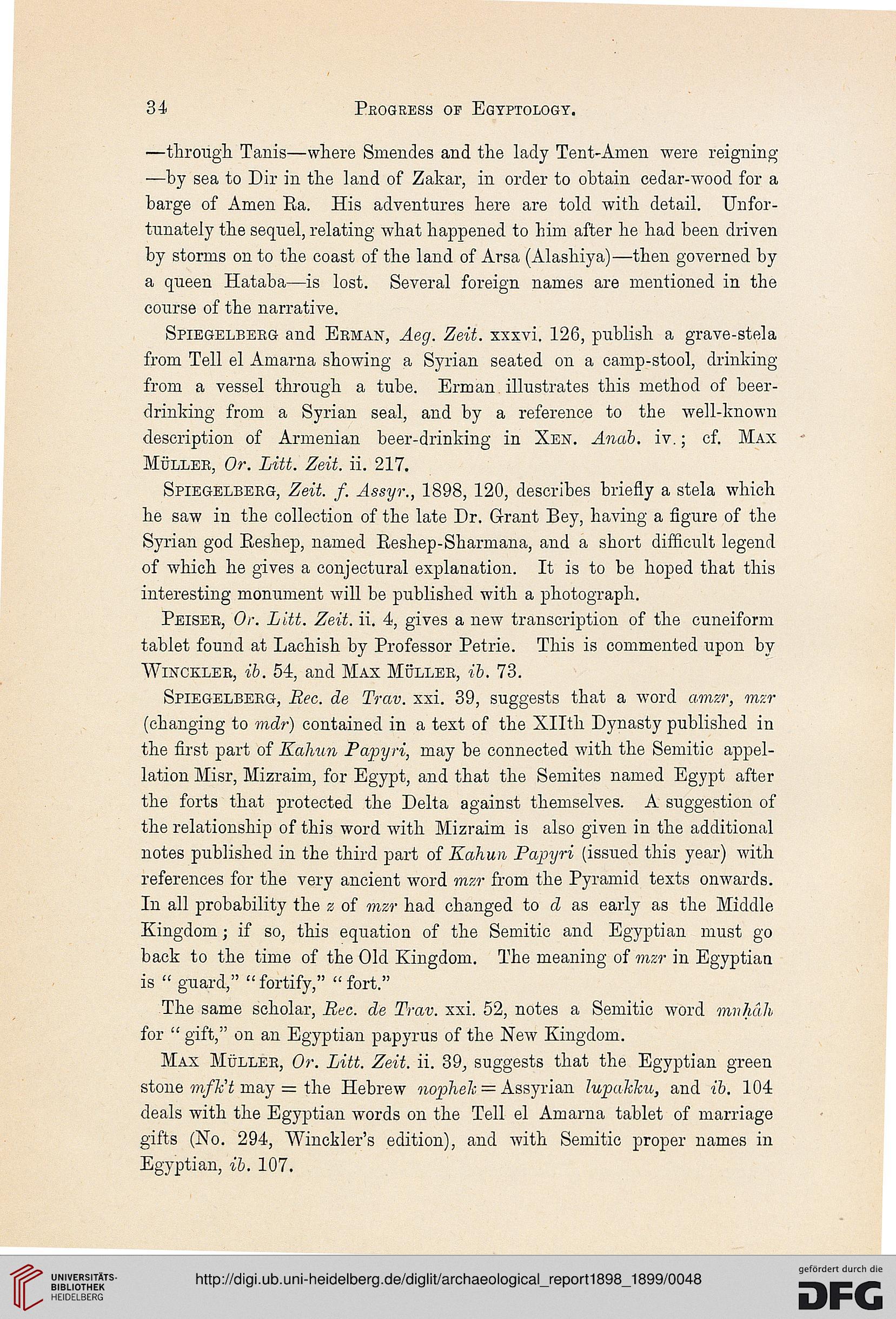34
Progress of Egyptology.
—through Tanis—where Smencles and the lady Tent-Amen were reigning
—by sea to Dir in the land of Zakar, in order to obtain cedar-wood for a
barge of Amen Ea. His adventures here are told with detail. Unfor-
tunately the sequel, relating what happened to him after he had been driven
by storms on to the coast of the land of Arsa (Alashiya)—then governed by
a queen Hataba—is lost. Several foreign names are mentioned in the
course of the narrative.
Spiegelbeeg and Eeman, Aeg. Zeit. xxxvi. 126, publish a grave-stela
from Tell el Amarna showing a Syrian seated on a camp-stool, drinking
from a vessel through a tube. Erman illustrates this method of beer-
drinking from a Syrian seal, and by a reference to the well-known
description of Armenian beer-drinking in Xen. Anab. iv.; cf. Max
Mulleb, Or. Litt. Zeit. ii. 217.
Spiegelbeeg, Zeit. f. Assyr., 1898, 120, describes briefly a stela which
he saw in the collection of the late Dr. Grant Bey, having a figure of the
Syrian god Keshep, named Eeshep-Sharmana, and a short difficult legend
of which he gives a conjectural explanation. It is to be hoped that this
interesting monument will be published with a photograph.
Peiseb, Or. Litt. Zeit. ii. 4, gives a new transcription of the cuneiform
tablet found at Lachish by Professor Petrie. This is commented upon by
Winckleb, ib. 54, and Max MSllee, ib. 73.
Spiegelbeeg, Rec. de Trav. xxi. 39, suggests that a word amzr, mzr
(changing to mdr) contained in a text of the Xllth Dynasty published in
the first part of Kahun Papyri, may be connected with the Semitic appel-
lation Misr, Mizraim, for Egypt, and that the Semites named Egypt after
the forts that protected the Delta against themselves. A suggestion of
the relationship of this word with Mizraim is also given in the additional
notes published in the third part of Kahun Papyri (issued this year) with
references for the very ancient word mzr from the Pyramid texts onwards.
In all probability the z of mzr had changed to d as early as the Middle-
Kingdom ; if so, this equation of the Semitic and Egyptian must go
back to the time of the Old Kingdom. The meaning of mzr in Egyptian
is " guard," "fortify," "fort."
The same scholar, Bee. de Trav. xxi. 52, notes a Semitic word mrihdh
for " gift," on an Egyptian papyrus of the New Kingdom.
Max Mulleb, Or. Litt. Zeit. ii. 39, suggests that the Egyptian green
stone mfKt may = the Hebrew nophch = Assyrian lupakhu, and ib. 104
deals with the Egyptian words on the Tell el Amarna tablet of marriage
gifts (No. 294, Winckler's edition), and with Semitic proper names in
Egyptian, ib. 107.
Progress of Egyptology.
—through Tanis—where Smencles and the lady Tent-Amen were reigning
—by sea to Dir in the land of Zakar, in order to obtain cedar-wood for a
barge of Amen Ea. His adventures here are told with detail. Unfor-
tunately the sequel, relating what happened to him after he had been driven
by storms on to the coast of the land of Arsa (Alashiya)—then governed by
a queen Hataba—is lost. Several foreign names are mentioned in the
course of the narrative.
Spiegelbeeg and Eeman, Aeg. Zeit. xxxvi. 126, publish a grave-stela
from Tell el Amarna showing a Syrian seated on a camp-stool, drinking
from a vessel through a tube. Erman illustrates this method of beer-
drinking from a Syrian seal, and by a reference to the well-known
description of Armenian beer-drinking in Xen. Anab. iv.; cf. Max
Mulleb, Or. Litt. Zeit. ii. 217.
Spiegelbeeg, Zeit. f. Assyr., 1898, 120, describes briefly a stela which
he saw in the collection of the late Dr. Grant Bey, having a figure of the
Syrian god Keshep, named Eeshep-Sharmana, and a short difficult legend
of which he gives a conjectural explanation. It is to be hoped that this
interesting monument will be published with a photograph.
Peiseb, Or. Litt. Zeit. ii. 4, gives a new transcription of the cuneiform
tablet found at Lachish by Professor Petrie. This is commented upon by
Winckleb, ib. 54, and Max MSllee, ib. 73.
Spiegelbeeg, Rec. de Trav. xxi. 39, suggests that a word amzr, mzr
(changing to mdr) contained in a text of the Xllth Dynasty published in
the first part of Kahun Papyri, may be connected with the Semitic appel-
lation Misr, Mizraim, for Egypt, and that the Semites named Egypt after
the forts that protected the Delta against themselves. A suggestion of
the relationship of this word with Mizraim is also given in the additional
notes published in the third part of Kahun Papyri (issued this year) with
references for the very ancient word mzr from the Pyramid texts onwards.
In all probability the z of mzr had changed to d as early as the Middle-
Kingdom ; if so, this equation of the Semitic and Egyptian must go
back to the time of the Old Kingdom. The meaning of mzr in Egyptian
is " guard," "fortify," "fort."
The same scholar, Bee. de Trav. xxi. 52, notes a Semitic word mrihdh
for " gift," on an Egyptian papyrus of the New Kingdom.
Max Mulleb, Or. Litt. Zeit. ii. 39, suggests that the Egyptian green
stone mfKt may = the Hebrew nophch = Assyrian lupakhu, and ib. 104
deals with the Egyptian words on the Tell el Amarna tablet of marriage
gifts (No. 294, Winckler's edition), and with Semitic proper names in
Egyptian, ib. 107.





